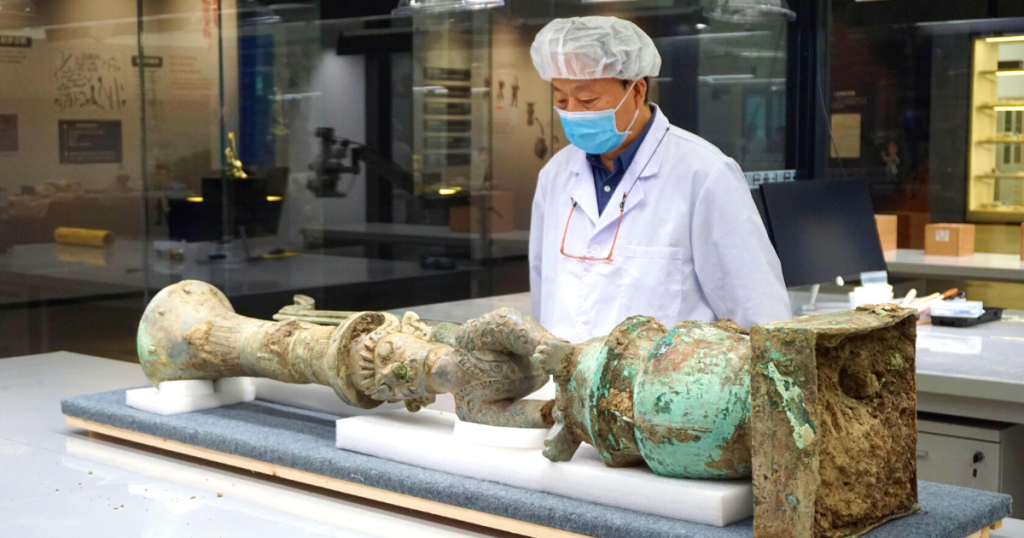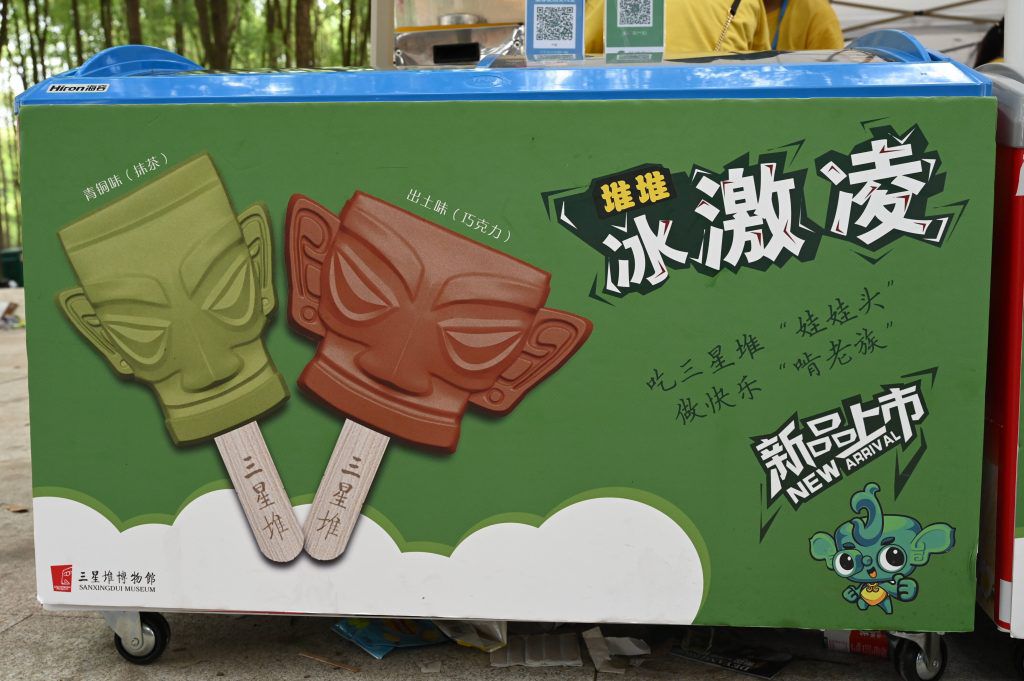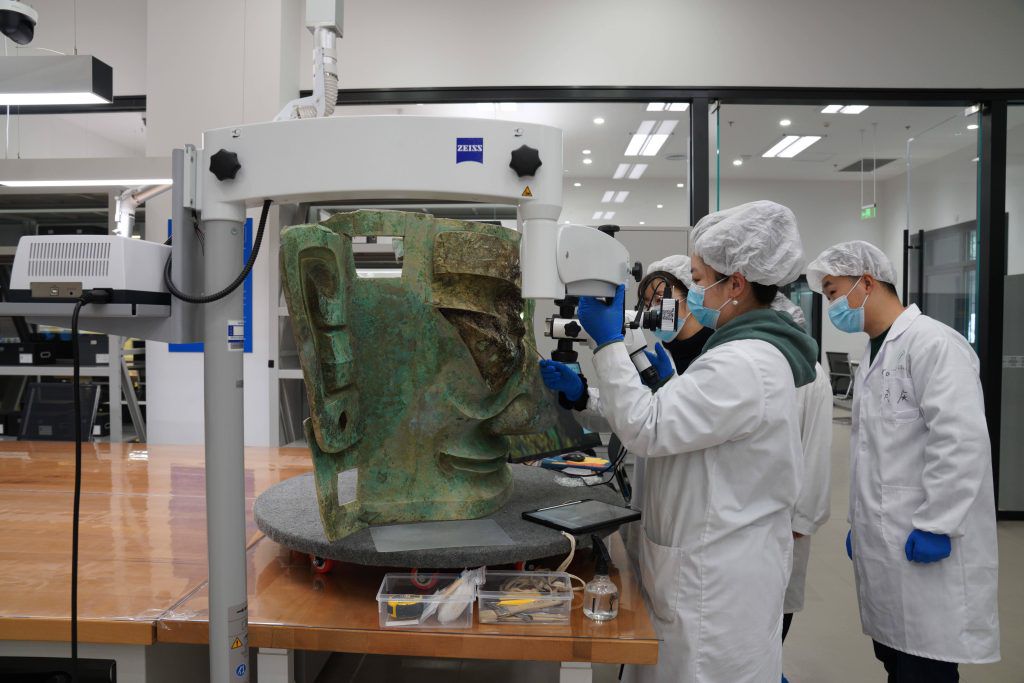The archaeological discoveries of Sanxingdui resemble something out of a surreal horror movie: Gigantic, boxy heads. Creatures with stalk eyes. Hybrid beings with snake bodies and bird legs. On top of that, a four-meter-tall bronze tree, with mysterious birds perched on its branches. These dramatically illuminated artifacts can be admired at the Sanxingdui Museum in the northeastern part of the excavation site, about 40 kilometers from Sichuan’s capital, Chengdu.
A mysterious culture sank them some 3,000 years ago in eight sacrificial pits, six of which have been uncovered since their discovery in the mid-1980s. At the end of March, archaeologists presented more objects to the public, including an altar and a chest in the shape of a turtle shell. “Spectacular finds,” as Prof. Dr. Maria Khayutina, a sinologist and expert on pre-imperial China at LMU Munich, tells China.Table. “Unfortunately, the Western world is quite uninterested in discoveries outside its cultural sphere. What is not familiar is often simply ignored.”
In China, on the other hand, live coverage of the excavations was broadcast for days this spring. Sanxingdui has long been part of local pop culture. At this year’s CCTV New Year’s Gala, the largest television event in the world, a choreography with Sanxingdui holograms was performed. On Chinese e-commerce sites, sneakers with Sanxingdui motifs can be purchased, and T-shirts, pen holders, popsicles, and emojis are also available in the shape of the distinctive bronze heads. In 2016, China’s movie industry even announced a blockbuster co-produced by US star director James Cameron, in which a visitor from a foreign land learns about Sanxingdui culture. The leading role in “The Guest of Sanxingdui” is to be played by none other than Arnold Schwarzenegger, who was also signed on as an international ambassador for the archaeological site.
In fact, not only Chinese historians consider Sanxingdui to be one of the most important archaeological discoveries of the 20th century – more important even than the terracotta army from Xi’an. At the same time, these objects seem so strange that for the most part they cannot be categorized with other discoveries from China. Who were the creators of these strange works? What was their purpose? Written documents or human remains are absent, making the matter even more mysterious. Last year, the state-run Global Times newspaper even felt compelled to publish an article ruling out an extraterrestrial origin of the Sanxingdui civilization.
China’s history should be rewritten
For a long time, the consensus among China’s historians was that Chinese civilization developed along the middle valley of the Yellow River. In the 1920s, archaeologists unearthed remains of the last capital of the Shang Dynasty in the central excavation sites of Anyang. Here they also discovered a large part of the famous oracle bones, which are considered the first evidence of Chinese writing.
During the excavations, civil war raged, and shortly after, the Japanese invaded. Both fueled the longing for a unified Chinese identity. Neolithic excavation sites along the Yangtze River or bronze finds in Gansu had already shaken the theory of the cradle of civilization in the heart of China after the Cultural Revolution. But it was the highly refined bronze objects in Sanxingdui, separated by mountain ranges, that turned the old world view upside down.
According to the official Chinese version, the Sanxingdui pieces are relics of the Shu kingdom, which is said to have lasted for more than 2,000 years. However, the Shu are more “Mystery than History”. “Shu is known as the name of a kingdom that existed in what is now Sichuan 1,000 years later,” Khayutina says. “Whether there was a direct connection between it and Sanxingdui, I don’t think has been definitively clarified.” Some scholars argue that the people of Sanxingdui maintained ties with cultures in Burma, Central Asia and India. Amateur scientist Su San even states in two books that Sanxingdui society descended from the Red Sea. The evidence for this, however, is as thin as the claim that Sanxingdui had been in active contact with aliens.
Proof of diversity of Chinese culture
Chinese historians are now mainly looking for commonalities in Sanxingdui. Professor Zhao Hao of Peking University, who is involved in the excavations at Pit No. 8, told state television last week that basic motifs of Chinese culture, such as dragons or the Zun vessels typical of the Shang Dynasty, were also found at Sanxingdui. “The idea of a culture in which different influences come together fits the concept of a modern nation much better than the old world view,” Khayutina explains. And indeed, in today’s China, Sanxingdui is seen above all as proof of how diverse Chinese culture has flourished outside its supposed center.
President Xi Jinping, who is personally pushing for the recognition of Sanxingdui as a UNESCO World Heritage Site, knows the power of a national myth that reinforces the image of a diverse and peace-loving trading partner in the era of the New Silk Road (China.Table reported). State news agency Xinhua quoted him as saying in October 2021 that the Sanxingdui excavations “reveal the origin and evolution of the Chinese civilization, its glorious achievements and great contributions to human civilization.”
Bombastic museum facilities
Also thanks to Xi, China is currently experiencing a “golden age of Chinese archaeology,” writes the South China Morning Post. While the Sanxingdui discoveries were still hauled away on bicycles in the 1980s, the excavation site is now one of the most modern in the world. More than 120 scientists from all over the country work here. Laboratories have been built above the pits, where humidity and temperature are precisely balanced. The archaeologists wear protective suits. Not a single hair or skin flake must be allowed to falsify the radiocarbon and DNA examinations.
A new 30,000-square-meter exhibition hall for the most recent finds is also in the planning stages. “China values its cultural heritage and also instrumentalizes it,” Khayutina says. “Bombastic museum facilities that Europe can only dream of are opened at every significant site.”
Excavations in the last remaining sacrificial pits are expected to be finished early next year. However, research on the Sanxingdui culture is just beginning, says Wang Wei, a historian at the Chinese Academy of Social Sciences in Beijing. “The next step is to look for larger architecture where, for example, the last altar found might have stood.” Then, perhaps, the pressing mystery for Chinese historians of how this highly advanced civilization could so suddenly disappear off the face of the earth will be solved.
Original




